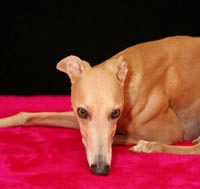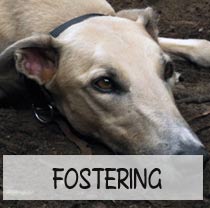 |
Welcome to the |
The Fast Facts
Retired racing Greyhounds are dogs like all others but they have some unique characteristics. They are generally intelligent, sensitive, gentle and sociable dogs which readily adapt to life as a family pet.
Do Greyhounds get along with cats?
Due to their breeding and high prey drive only about 5% - 10% of Greyhounds are cat tolerant.
Even then this would only be if the cat lived entirely indoors. If your cat lives outside we could not guarantee the safety of your cat. Therefore we only adopt cat-tolerant Greyhounds to homes where the cat lives inside all of the time. We are happy to put your name on the waiting list for a cat tolerant Greyhound.
Do Greyhounds get along with other dogs?
Greyhounds are quite placid and happy to get along with any dog.
However, the introduction of the dogs is important and should be conducted on neutral territory.
Greyhounds also sleep for long periods, and would not be a good match for a high energy dog.
Some existing dogs may resent a newcomer so care needs to be taken.
Greyhounds in flats
Greyhounds are wonderful dogs in flats or apartments.
They are clean non-smelly dogs who rarely bark, sleep a lot, require little exercise and don't shed much.
However, they do need toileting during the day - they can no more keep their legs crossed for 6 - 8 hours than you can! If you live in a flat or unit and work, then you need to think about how to toilet your dog (indoor toilets are not possible with a large dog). The options include coming home at lunchtime to take the dog out, or arranging a friend/relative/dog walker to come by and take the dog out.
Additionally we will need written permission from your body corporate and landlord (if you are renting) before we can proceed.
Renting and Greyhounds
Many landlords don't realise how great Greyhounds are, so they restrict a renter's access to owning a dog.
Greyhounds need to sleep inside due to their lack of body-fat coverage.
You'll need written permission from your landlord to keep a large dog inside the house before you can proceed with us.
Do Greyhounds need a lot of exercise?
Despite the image people have of them, they do not require lots of exercise. One twenty minute walk per day is all that is required to keep them happy and healthy. Like a cat, the Greyhound will find the cosiest place in the house (usually your bed or the sofa) and will be content to sleep there all day. Despite being large dogs, they can curl up into small areas, and seldom get under your feet.
Do they make good guard dogs?
Greyhounds rarely bark, usually only when something is wrong or when they get very excited. If you want a guard dog, the Greyhound is not the breed for you. They will 'watch' everything - but that's usually as far as they go. For most Greyhounds, everyone they meet is greeted as a friend. Greyhounds are great leaners and may rub up against your leg like a cat. Some individuals are a little more aloof when in the company of strangers.
What is a "sighthound"?
The Greyhound is a strong, muscular dog, built for sprinting over short distances. In fact, with the exception of the cheetah, the Greyhound is the fastest creature on earth. The breed belongs to the sighthound (or gazehound) group which includes Afghans, Borzoi, Salukis, Deerhounds, Irish Wolfhounds, Pharaoh Hounds, Whippets etc. These are breeds which hunt their quarry primarily by sight rather than scent. Although the Greyhound has been used for hunting various species over the centuries, their natural quarry is the hare.
How big are Greyhounds?
Male Greyhounds range from 67 - 72cm in height and approx. 30 - 35 kg in weight. Bitches are generally smaller, at 62 - 68 cm and 24 - 30 kg. Because they are selected for speed and fitness, Greyhounds suffer from very few heritable diseases. For example, hip dysplasia is almost unheard of in the breed.
Are males or females better?
 Many people, when making the decision on whether they would like a boy or a girl, have preconceived ideas. Based on their experience with other breeds, issues such as male dominance or aggression, "leg cocking" and overall size are frequently to the forefront when expressing a preference for females. These widely held views often mean that we have quite a long list of people waiting to adopt a girl, but not so much demand for our beautiful boys. This is a great pity because the truth is that Greyhound boys are even more soft natured than the girls.
Many people, when making the decision on whether they would like a boy or a girl, have preconceived ideas. Based on their experience with other breeds, issues such as male dominance or aggression, "leg cocking" and overall size are frequently to the forefront when expressing a preference for females. These widely held views often mean that we have quite a long list of people waiting to adopt a girl, but not so much demand for our beautiful boys. This is a great pity because the truth is that Greyhound boys are even more soft natured than the girls.
Boys rarely, in our experience, attempt to dominate other dogs, whether male or female - if anything, the girls can be a bit more "forward" than the boys! Additionally, Greyhound boys are very clean and don't cock their legs on furniture or indoor plants - nor do they need to mark every tree when out on a walk! Some boys don't cock their leg at all - but we know some girls that do! Whilst boys are, generally, larger than girls, in reality it makes no difference. Since Greyhounds are essentially lounge lizards and spend most of their time relaxing and sleeping, their physical size is of little or no consequence. For example, they would take up much less space than a small dog that is more active and this is confirmed by the boy greyhounds who are happily living with their new families in small inner city terraces!
If you have decided that you would like to share your life with a Greyhound, we hope that you will consider a boy. The waiting time will be shorter and you will end up with wonderful companion who has none of the problems that you may have expected to come with a male dog.
How long do they live?
The average lifespan for these dogs as pets is ten to twelve years, and they are a breed which truly grows old gracefully.
What about their coat?
Greyhounds have a very fine, soft coat. Because of this, and their low body fat, they tend to feel extremes in temperature (both heat and cold) more than most dogs. So on cold winter nights your Greyhound will probably try to share your electric blanket or snuggle underneath your doona! Greyhounds come in a vast array of coat colours: black, white, red, blue, fawn, brindle, or any of these colours broken with white. Despite their name, grey (or blue as it is known) is not a very common colour in the breed.
How well does a retired racer adapt to family life?
Most retired racing Greyhounds adapt very quickly to life as a family pet and companion. After the physical and emotional stresses of life as an athlete, Greyhounds tend to glide effortlessly into their new role as 'couch potatoes'. Some things they have probably not experienced before include stairs, slippery floors, mirrors, glass doors, televisions or vacuum cleaners. As they are naturally very clean animals, house training is generally not a problem once a daily routine has been established. Most Greyhounds are seasoned travellers and really enjoy rides in the car. Because of their long bodies and high centre of gravity some find it difficult to balance in normal sedans and travel best in hatchbacks or station wagons.
Are Greyhounds OK with children and other pets?
Many Greyhounds while racing never experience other dog breeds or small animals such as cats or guinea pigs. As they have been bred as hunters for centuries, the instinct to chase is very strong in some dogs. Most Greyhounds are very sociable and will mix readily with other dogs if introduced correctly. Some retired dogs will get along well with cats; others are too 'keen' to live successfully with them. Generally, Greyhounds are very gentle with children, prefering to walk away from a pestering child; however, young children (especially under-fives) should never be left to play unsupervised with a dog of any breed.
What do these dogs eat?
Despite their large size, Greyhounds are not expensive to feed. Most Greyhounds in race training are fed kibble plus up to 0.5kg fresh meat per day. Once retired, a good quality dry commercial food (eg. our dogs in foster care are fed a premium dried dog food) supplemented with occasional tablescraps is all that is required. As with all large or giant breeds, meals should be fed twice daily and all exercise or excitement avoided around mealtimes to prevent 'bloat'. Retired racers will generally put on some weight after adoption, but should not be allowed to become overweight.
Can my Greyhound be trained to obey my commands?
Greyhounds are used to walking on a lead and generally heel readily without pulling. They will rarely if ever sit, unless taught to do so, preferring to stand or lie down. The Greyhound is a very intelligent breed and will learn new commands or exercises quickly, but can easily become distracted or bored. Obedience training is important for any dog being adopted into a new home. However, for the aristocratic and sensitive Greyhound, only gentle training methods employing positive reinforcement should be used. A Greyhound should never be allowed to run off lead unless in a fully fenced and safe area. Their combination of great speed and complete lack of traffic sense means they will almost certainly be killed if allowed to venture near the road. Under current NSW law, Greyhounds registered on the Companion Animal Register are not required to be muzzled in a public place, except an off-leash park.Greyhounds are required to wear muzzles in off-leash parks unlesst hey have passed by the Greyhound Adoption Program National Temperamant Test.
What happens during the "fostering" period?
Dogs accepted into the Greyhound Adoption Program (GAP) are first checked by a veterinarian. Most retired Greyhounds are fit and healthy and in the prime of their lives (usually two to five years old). Some may have minor injuries which stop them being competitive on the track, but which will not affect them in their new role as a family pet. The dogs are then placed in (temporary) foster homes, usually for three to four weeks, to help acclimatise them to life outside the racing environment. Foster carers introduce the Greyhound to small animal breeds, children, and various household experiences that kennel dogs are unfamiliar with at first. The progress of each dog is monitored carefully and their suitability for rehousing assessed. Once a Greyhound has passed this 'debriefing' and evaluation stage, he/she is desexed, teeth cleaned, microchipped, vaccinated, wormed, and tested for heartworm infection. Monthly heartworm preventative is commenced and flea treatment administered where required during the warmer months. When fully recovered from surgery, the Greyhound is ready to be adopted. The sex, size and, most importantly, the personality of the Greyhound is taken into account when matching with a prospective adoptive family.
How much does it cost to adopt a Greyhound?
Greyhounds placed in new homes come with a suitable collar and lead, identification tag, coat and muzzle. An adoption fee, at present $200, is charged to cover some of our veterinary and other expenses.
If you have never before considered making a retired racing Greyhound part of your life, then perhaps now is the time to give it some serious thought. The Greyhound will never be a breed that suits everyone, but if you are a responsible pet owner, have a well fenced yard and an understanding of the sighthound temperament, it may be the dog to consider.
Need more information?
If you would like further information on adopting or fostering retired racing Greyhounds, email us, or phone our adoption rep on 02 9452 3446.






